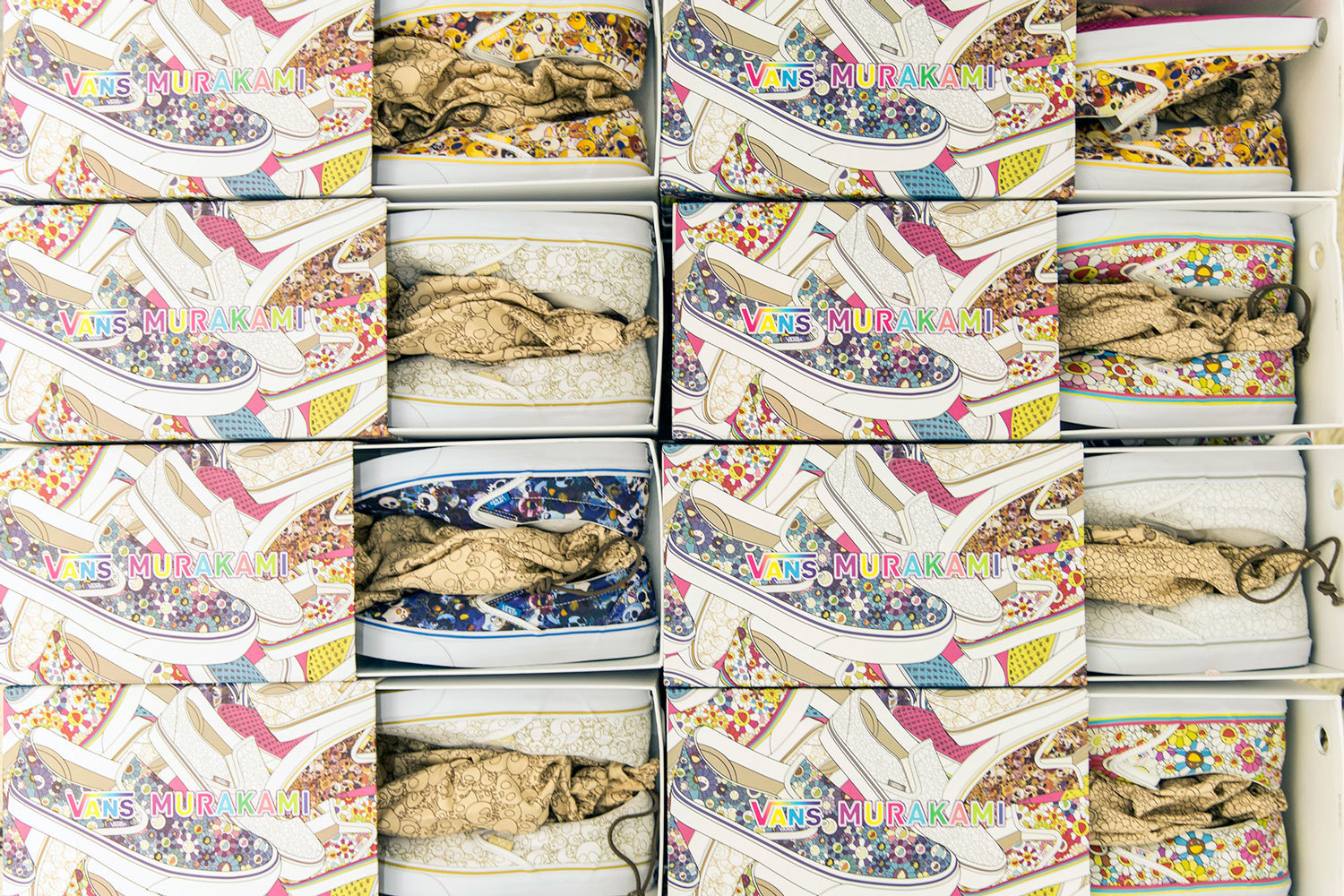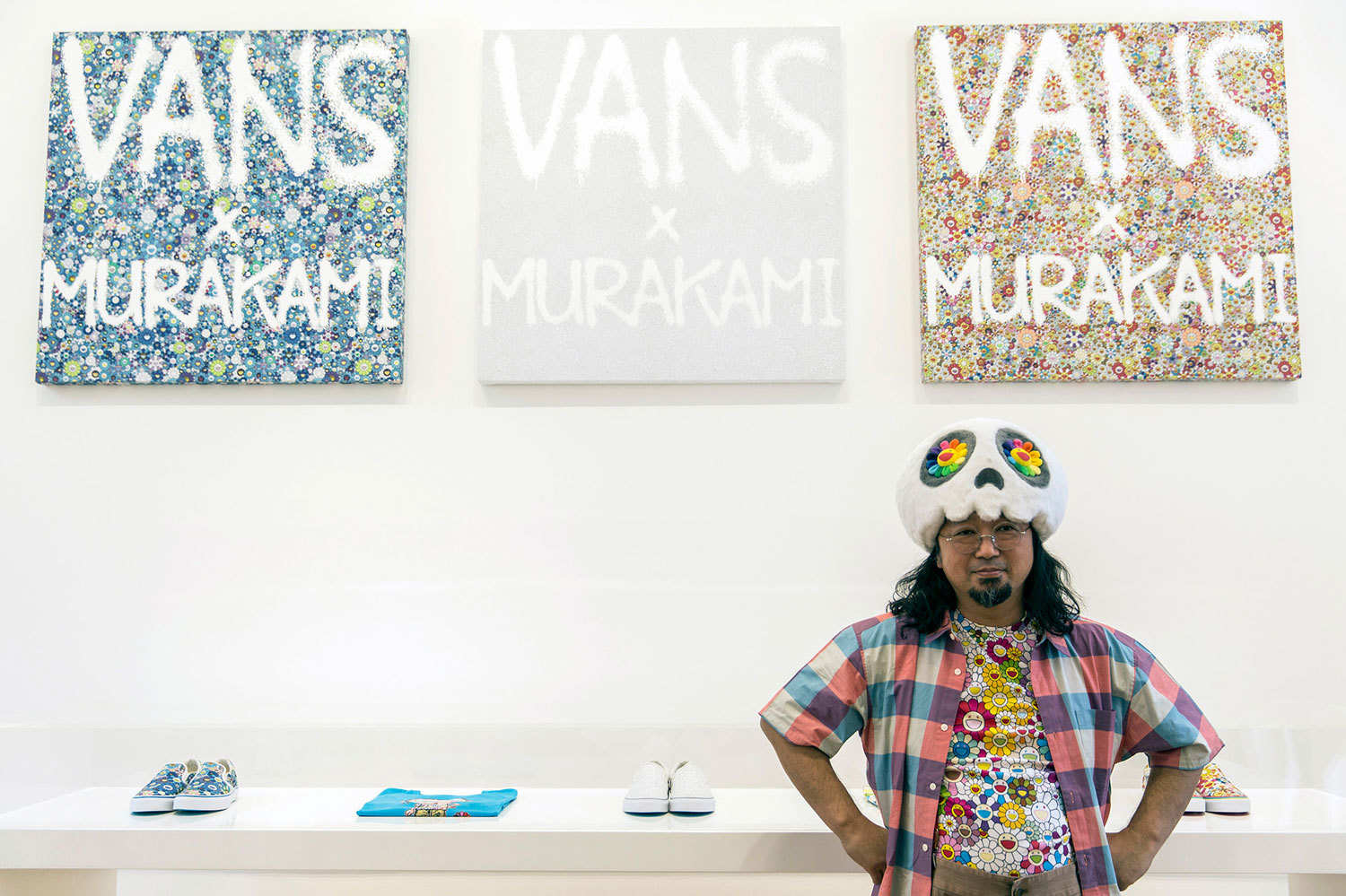Takashi Murakami has turned his hand to pretty much every art form out there: paintings, sculptures, prints, films, music videos, even taking his signature, magna influenced style to the iconic Louis Vuitton pattern.
Like the generation of American pop artists who came before him, Murakami obliterates distinctions between high and low art, commercial collaborations and conceptual works, trying to redefine the artist’s role for the 21st century. He’s exhibited across the world, creating icons of pop art, recently released his first feature film, and has now turned his distinctive, skull and flower prints to the equally distinctive silhouette of the Vans slip-on for a limited edition collaboration, that sold out almost instantly, and saw people queuing around the block to get ahold of in London.
Can you tell me about your creative process for the shoes?
The first thing I started with was a very small drawing of the flower, and from there I repeated it into this pattern. Varying it each time. I think this flower design if very positive.
Do you want people to feel positive when they see your art?
People here, in the West, like my work more than in Japan. Japanese people are against me, the geeks hate me, because I use Japanese geek things and they think I’m stealing it to export to the Western world.
Is the commercial opportunity of these collaboration important for you as a form of mass communication?
Yes very much because, well I’m Japanese, and Japanese culture doesn’t fit within this Western distinction of high and low art, we’re just very more involved with our subcultures, for us the established forms are animations, games, comics, these are high prestige in Japan, and this isn’t high art in the west.

Do you think you giving anything back to the geeks in your work?
I take my ideas from geek culture, sure, but they also take their ideas from me now. There is this Japanese animation, it’s a very big hit in Japan, I don’t know the name in English, it’s this story of a magical princess and it has a monster that is exactly Mr Dob! My original character. So it has been an influence between me and geek culture too, its back and forth, but they still hate me! It’s OK.
What was the difference with working with Vans, compared to Louis Vuitton?
At Louis Vuitton, with Marc Jacobs, we communicated over email, I sent Marc 70 or 80, images, and he chose one or two. We communicated maybe ten times for the first collaboration, but this time Vans said yes to everything! They are very West Coast, very relaxed, very different from Marc Jacobs.
So was that the attraction of working with Vans?
For 15 years I’ve worn Vans everyday in my studio, I have sixty pairs! I wouldn’t say I was a fan, Vans are like drinking water or breathing air, they are so natural to me. So Steve, from Vans, had read in an interview I did that I said, after working with Louis Vuitton, the only other brand I’d like to work with, are Vans. So he came to my studio in Japan when I was finding it hard to come up with ideas, but he convinced me to use these very iconic prints, it was very relaxed.
Why the flower and skulls prints?
It is what I do everyday, the flowers and the skulls, it’s like the air I breathe, and because I wear Vans everyday, it was like mixing air and air.
Flowers and skulls, life and death, these themes are always re-occurring in your work, why?
It’s a very honest thing, very spitirual, very primitive. Maybe it’s nessecary to create religion, as humans, to understand everything, to natural disasters?
For example, the Japanese earthquake and tsunami, in 2011, it was very shocking, the earthquake and tsunami, how nature can kill tens of thousands of people. I remember seeing young kids in a TV documentary after the disaster, the interviewer says “where is your dad” and the young people points to the sky and says, “in the stars.” It’s very primitive, this kind of natural, spiritual, thing, the parents are dead but the kid isn’t crying, he believes his parents are in the sky. But its shocking, this, because it’s a natural disaster, not war, it’s nature that is taking life, and people cannot do anything, its very sad.
You’re other work recently has been influenced by traditional Japanese Enso calligraphy, what made you return to this?
The image of the zen monk drawing the circle, Japanese calligraphy,is some times seen as the start of Japanese manga, even though Enso is very serious, but at the same time, it’s very free. I’m trying to be like this, when I’m making paintings at the moment, to feel like this, serious but free.
But you’re using spray paint, not a brush and ink.
Every day I was watching the news, seeing ISIS and Gaza and war zones, and I was seeing so many spray painted messages, this was like zen philosophy I thought, these simple messages like ‘fuck the world’, ‘save the world’, no war’,
These simple emotions are very pure motivations for making paintings, I wanted to be close to this feeling by using spray paint. To this this feeling of emptiness and purity.
Credits
Text Felix Petty
Photography courtesy Vans
